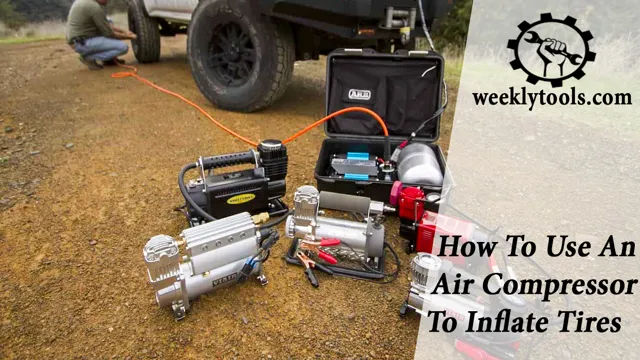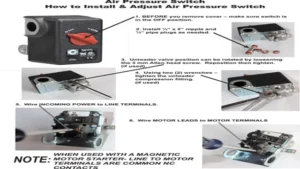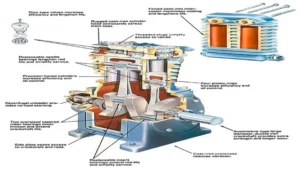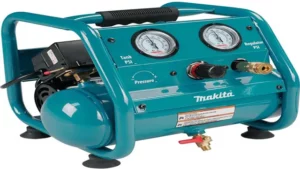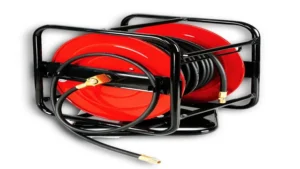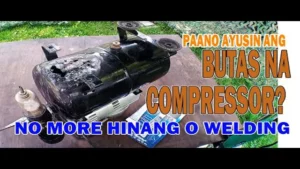Tire maintenance is an essential aspect of vehicle ownership. Whether you are a seasoned driver or just starting, regular tire inflations avoid hindrances like low traction, tire blowouts, and increased fuel consumption. Air compressors are a popular solution, primarily due to their simplicity and cost-effectiveness.
However, utilizing an air compressor adequately requires some expertise and a careful eye. In this step-by-step guide, we will take you through the basics of using an air compressor for tires. From setting the right PSI to using the air gun in a controlled manner, we’ve got you covered.
So sit back, grab your favorite beverage, and read on to learn how to inflate your tires and keep them in the best shape possible for a seamless driving experience.
Gather Your Materials
If you’re looking to use an air compressor to inflate your tires, the first step is to gather all the necessary materials. Firstly, you’ll need to ensure that the air compressor you’re using is compatible with your tires. Check the manufacturer’s recommendations or talk to a professional if you’re unsure.
Once you’ve got the right compressor, make sure it’s set up correctly and ready to use. You’ll also need a tire pressure gauge to check the current pressure in your tires and monitor it as you inflate them. Finally, you’ll need the valve stem adapters that fit your tire valves.
Some compressors may come with these adapters, but if not, you will need to purchase them separately. Once you’ve gathered everything you need, you’re ready to get started. Remember to always follow the manufacturer’s guidelines and safety precautions when using an air compressor.
Air compressor
When it comes to using an air compressor, gathering your materials is one of the most important steps to ensure a smooth and efficient process. The first thing you’ll need is the air compressor itself, which can come in different sizes and types depending on your specific needs. Make sure to also gather the necessary hoses and fittings to connect to your air compressor, as well as any attachments or accessories you may need for your particular task.
It’s also crucial to have safety equipment on hand, such as eye and ear protection, to prevent any accidents. Lastly, don’t forget to prepare your workspace by ensuring proper ventilation and a clear area free of any potential hazards. By taking the time to gather all your materials beforehand, you can ensure a successful and safe use of your air compressor.

Tire pressure gauge
When it comes to checking your tire pressure, having the right tools is key. One of the most important tools is a tire pressure gauge. To start, you’ll need to gather a few materials.
First, make sure you have a tire pressure gauge that is appropriate for your vehicle. You can find this information in your car’s owner’s manual or by checking with a mechanic. Next, you’ll need a source of air, such as an air pump or an air compressor.
Make sure the source you choose is suitable for your gauge and your tire’s specific pressure needs. Finally, make sure you have a tire pressure chart available to help you determine the recommended pressure for your vehicle’s tires. Once you have these materials in hand, you’ll be ready to check your tire pressure accurately and safely.
By regularly checking your tire pressure, you can help to prevent blowouts, extend the life of your tires, and improve your vehicle’s fuel efficiency. So, make sure you have your tire pressure gauge and the necessary materials on hand and start making tire pressure checks a regular part of your vehicle maintenance routine.
Tire valve stem tool
When it comes to changing a tire or inflating it, the tire valve stem tool is a must-have in your toolbox. This simple device allows you to remove and install valve stems without damaging the tire or the rim. To gather your materials for this task, you’ll need a valve stem tool, a replacement valve stem, an air compressor, and an appropriate tire pressure gauge.
The valve stem tool is usually made of metal and comes in different sizes and shapes depending on the type of valve stem you’re working with. It’s always best to use the correct tool to avoid any damage to the tire or rim. Once you have everything you need, it’s time to get to work.
Remember to always follow the manufacturer’s instructions and take safety precautions, such as wearing gloves and eye protection. After all, a flat tire on the road can be a dangerous situation. With the right materials and some basic knowledge, you’ll be able to change and inflate your tires safely and effectively.
Tire filler tool
When it comes to DIY projects like fixing a flat tire, having the right tools is essential. One must-have tool is a tire filler. To make a tire filler, you will need several materials.
Firstly, grab a bike pump with a gauge to accurately measure the tire’s pressure. Next, you’ll need an air compressor or a CO2 cartridge for faster inflation. A valve stem tool is also necessary for removing valve cores if needed, and Teflon tape for sealing the connections.
Lastly, grab a brass hose barb and a couple of hose clamps to connect the pump hose to the fill valve. With these materials, you’re ready to create a tire filler tool that will help you quickly and easily inflate your tire to the correct pressure. Be sure to test it out before you need it in an emergency, so you’re confident in its functionality.
Happy tinkering!
Preparing for Use
When it comes to using your air compressor for tire inflation, there are a few things you should consider to ensure you are prepared. Firstly, make sure you have the appropriate accessories for your compressor, including the correct size tire chuck and hose fittings. Next, check the tire pressure requirements for your vehicle, as over-inflating or under-inflating your tires can impact your safety and vehicle performance.
Before beginning, it’s also important to inspect your compressor and hose for any damage or leaks. Once you’ve taken these steps, attach the chuck to the tire valve stem and turn on the compressor. Keep an eye on the pressure gauge as you inflate the tire, taking breaks as needed to prevent overheating.
Once you’ve reached the desired pressure, turn off the compressor and disconnect the chuck. Using your air compressor for tire inflation can be a convenient and efficient way to keep your tires properly inflated for optimal performance and safety on the road.
Find recommended PSI for your tire
One of the essential steps in preparing your car for use is ensuring that your tires are inflated to the recommended PSI. The PSI, or pounds per square inch, refers to the amount of air pressure inside your tires and directly affects their performance and longevity. Underinflated tires can lead to reduced fuel efficiency, poor handling, and even premature wear.
On the other hand, overinflated tires can make your car feel stiff, bouncy, and decrease their lifespan. To find the recommended PSI for your specific tires, start by checking the owner’s manual or the decal located on the driver’s side door jamb. You may also find the information on the tire’s sidewall, but the number provided is the maximum allowable PSI, not necessarily the recommended level.
Using a reliable tire pressure gauge, check your tire’s pressure when they are cold, meaning before driving or after less than a mile of driving. Adjust the inflation level accordingly until it matches the recommended PSI. By keeping your tires inflated to the right level, you can enhance your driving experience, improve your car’s safety, and maximize their lifespan.
Ensure compressor is off and unplugged
When it comes to using a compressor, it’s crucial to ensure that it’s turned off and unplugged before you start preparing for use. This may seem like an obvious step, but it’s one that’s often overlooked. By taking a few moments to make sure your compressor is in the right condition, you can help to prevent accidents and keep it running smoothly.
Start by checking the power cord and making sure it’s not frayed or damaged in any way. If it is, replace it before you use the compressor. Then, inspect the compressor itself and make sure there are no loose or damaged parts that could cause a hazard during operation.
Finally, double-check that the compressor is unplugged and take a deep breath. You’re now ready to start using your compressor with confidence and peace of mind.
Using the Compressor
Are you wondering how to use an air compressor for tires? Look no further! Using an air compressor for tires is a simple and efficient process. First, ensure that your compressor is plugged in and turned on. Next, attach the air hose to the tire valve stem.
Make sure it is securely fastened and not leaking air. Turn on the compressor and allow it to fill the tire. Keep an eye on the pressure gauge and stop filling once it reaches the desired pressure level.
Be sure to double-check the pressure with a tire gauge, as overinflated tires can be dangerous. With these simple steps, you can easily and safely use your air compressor for tire inflation.
Attach hose to compressor and tool
“Compressor and Tool Hose Attachment” Using a compressor can be a game-changer when dealing with heavy-duty tasks. Whether you’re a professional or a DIY enthusiast, having the right tools can help get the job done more efficiently. One essential component of a compressor setup is the hose.
Knowing how to attach the hose to both the compressor and tool properly is crucial for a smooth operation. First, ensure that the compressor and tool are switched off. Then, attach the female end of the hose onto the compressor outlet by twisting until secured.
Next, connect the male end onto the designated inlet on the tool. Double-check your connections, making sure they are tightened enough to prevent air leaks. Once everything is secured, you can turn on the compressor and tool to begin work.
It’s essential to follow these steps as mistakes can lead to hazardous situations. With this vital knowledge, you’ll be ready to tackle various tasks with ease using your compressor and tool hose attachment.
Attach tool to valve stem of tire
One important step to using a compressor to inflate your tires is to attach the tool to the valve stem of the tire. This is the part of the tire that protrudes out and connects to the compressor. It’s essential to ensure a proper fit when attaching the tool to the valve stem to avoid any air leakage.
First, remove the valve cap from the tire valve stem, then align the tool’s nozzle with the stem’s opening and push it firmly onto the stem. You should hear a slight hissing sound of air escaping, indicating that the valve is open. Make sure the connection is tight and secure by firmly holding the tool in place while inflating the tire.
Once you’re done adding air and reaching the desired pressure level, remove the tool from the valve stem and put back the valve cap. It’s crucial to take your time and ensure a secure connection when attaching the tool to the valve stem to prevent any accidents from happening.
Turn on compressor and inflate to recommended PSI
When it comes to inflating your tires, using a compressor is the quickest and most efficient method. First, make sure you have the right equipment, including an air hose with a pressure gauge and the recommended amount of PSI for your tires. Then, attach the hose to the tire’s valve stem and turn on the compressor.
You’ll hear the sound of air rushing into the tire, and you’ll want to pay attention to the pressure gauge to make sure you don’t overinflate. Once you’ve reached the recommended PSI, turn off the compressor and remove the hose from the valve stem. Overinflating your tires can be just as dangerous as underinflating, so make sure you’re using the right amount of pressure.
Taking the time to properly inflate your tires can improve your gas mileage and make your car safer to drive on the road. So, don’t forget to regularly check and fill up your tires to keep your car running smoothly.
Checking Tire Pressure
If you want to ensure that your tires are performing at their best, it’s important to keep their pressure levels in check. Using an air compressor is a straightforward and efficient way to do this. First, locate the recommended tire pressure for your vehicle on the manufacturer’s sticker, typically found on the driver’s side doorjamb.
Make sure your compressor is set up correctly and attach the air hose to the tire valve stem. Turn on the compressor and wait for the gauge to read the desired pressure, periodically checking the tire pressure with a separate gauge to ensure accuracy. Remember, over- or under-inflated tires can affect your vehicle’s handling and fuel efficiency, so make sure to perform this task regularly and thoroughly.
With this simple process of using an air compressor, you can ensure that your tires remain well-maintained, safe, and efficient.
Turn off compressor and detach tool from valve stem
Checking tire pressure regularly is essential to maintain your vehicle’s safety and performance. One crucial step in this process is to turn off the compressor and detach the tool from the valve stem once you’ve finished inflating the tire. Don’t forget to do this, as leaving the tool attached can cause the tire to overinflate, resulting in potential hazards on the road.
Moreover, overinflated tires cause instability in the vehicle, decreasing fuel efficiency and wearing out the tires prematurely. In contrast, underinflated tires aren’t safe either, as they can lead to poor traction, reduced handling, and even blowouts. Therefore, it’s vital to check the tire pressure frequently and adjust it as needed to keep your vehicle running smoothly.
It’s worth investing in a quality tire pressure gauge to make sure you’re getting accurate readings and avoiding costly mistakes. Ensuring proper tire pressure not only ensures your safety but also protects your investment in car maintenance. Don’t neglect this vital aspect of vehicle upkeep and drive with greater peace of mind knowing that your tires are in top shape.
Use tire pressure gauge to check PSI
Checking tire pressure is a crucial step in ensuring your vehicle is safe and efficient on the road. One effective way to check the air pressure in your tires is by using a tire pressure gauge. This handy tool allows you to accurately measure the psi (pounds per square inch) of each tire, ensuring they are all within the recommended range.
To use a tire pressure gauge, simply remove the valve cap from one tire and press the gauge onto the valve stem. The gauge will display the current psi level, and you can compare it to the recommended level provided in your vehicle manual or on a label inside the driver’s door. By regularly checking your tire pressure with a gauge, you can help prevent tire blowouts, improve fuel efficiency, and save money in the long run.
So don’t forget to add this simple step to your vehicle maintenance routine!
If necessary, repeat inflation until desired PSI is reached
When it comes to maintaining proper vehicle performance, checking tire pressure is a crucial step. If your tires are underinflated, they can cause your vehicle to handle poorly, reduce fuel efficiency, and even damage the tires themselves. The first step is to find out what the recommended PSI is for your specific tires, which can usually be found in your vehicle manual or on a sticker located on the driver’s side door panel.
Next, you will need a tire pressure gauge to accurately measure the current pressure of each tire. Once you have this information, it’s time to inflate or deflate your tires as needed. Inflate your tires by adding air in small increments until the desired PSI is reached.
If you overshoot, you can always release some air until you reach the recommended pressure. It’s essential to monitor your tires regularly as they lose air pressure over time, and repeat the inflation process as necessary. This practice will keep your vehicle running smoothly, efficiently, and help your tires last longer.
Conclusion: Proper Tire Maintenance Made Easy
To sum it up, using an air compressor for tires is a breeze. Inflate with ease, maintain correct pressure with ease, and make sure to drop the mic before you leave. Happy tire inflating!”
FAQs
What is an air compressor and what is its purpose for inflating tires?
An air compressor is a device that compresses air and stores it in a tank for later use. Its purpose for inflating tires is to push air into the tire at a fast rate, filling it up to the desired level quickly and efficiently.
What type of air compressor is best for inflating tires at home?
A portable or small-sized air compressor is best for inflating tires at home. These types of air compressors are easy to move around, don’t take up much space, and are suitable for quick tire inflation jobs.
Can you use an air compressor to inflate all types of tires, including bicycles and motorcycles?
Yes, you can use an air compressor to inflate all types of tires, including bicycles and motorcycles. As long as the air compressor has the correct pressure gauge and fittings, it can easily inflate any size or type of tire.
How do you connect an air compressor to a tire for inflation?
To connect an air compressor to a tire for inflation, you will need to attach the air hose nozzle to the tire’s valve stem. Make sure to tighten it securely, turn on the compressor, and monitor the pressure level until the desired level is reached.
Is it safe to inflate a tire with an air compressor at a gas station?
Yes, it is safe to inflate a tire with an air compressor at a gas station. Most gas stations have air compressors available for public use, and they are designed to be used safely by customers. However, make sure to follow all safety precautions and instructions provided.
What pressure should tires be inflated to, and how do you know when they have reached the correct pressure?
Tires should be inflated to the pressure listed in the vehicle’s owner’s manual or on the tire itself. You can use a tire pressure gauge to measure the pressure, and most air compressors come with a built-in gauge to help you determine when the tire has reached the correct pressure.
Are there any safety precautions to take when using an air compressor to inflate tires?
Yes, there are some safety precautions to take when using an air compressor to inflate tires, such as wearing protective eyewear and gloves, keeping the compressor away from flammable materials, and making sure not to overinflate the tire. Always follow the manufacturer’s instructions and safety guidelines when using an air compressor.
